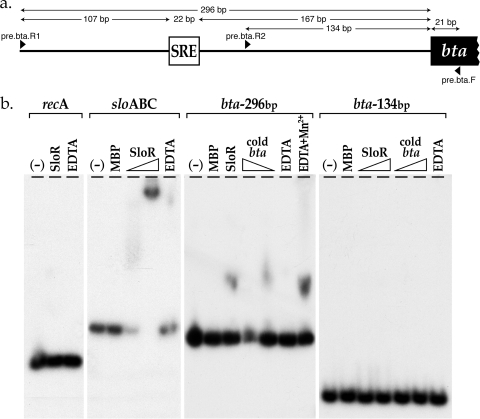FIG. 4.
SloR binds directly to the bta promoter region. The results of EMSA confirm a direct and specific interaction between the S. mutans bta promoter region and a SloR-MBP fusion protein. Specifically, a 317-bp amplicon that harbors 296 bp of upstream sequence relative to the bta start codon and the predicted promoter-distal SRE (a) was end labeled and mixed with up to 4.4 μM SloR-MBP before the protein-DNA mixture was resolved on a nondenaturing polyacrylamide gel (b). Run in parallel was the naked 317-bp amplicon in the absence of the fusion protein. A 212-bp amplicon on which the recA promoter region is resident and a 310-bp amplicon that harbors the sloABC promoter region served as negative and positive controls, respectively. A band shift was evident in the sloABC and bta-296 reaction mixtures, indicating direct SloR binding to these SRE-containing amplicons. There was no observable shift of the recA negative control, which lacks a predicted SRE. There was also no band shift when the bta promoter region was incubated with MBP alone, supporting the interaction of the SloR portion of the fusion protein with the DNA binding site. Importantly, a bta amplicon of 155 bp that lacks the predicted SRE (a) was also not shifted by SloR-MBP, supporting a specific interaction between the SloR fusion protein and its target SRE, which is resident on the bta-296 amplicon. The addition of cold bta competitor DNA or EDTA (1.5 mM) to the sloABC and bta-296 reaction mixtures abrogated the band shifts, whereas the addition of manganese to the EDTA-containing mixture rescued the shift. These findings support both the specificity and the metal ion dependence for binding of SloR to an SRE that is located promoter distal to the class II gene bta.

